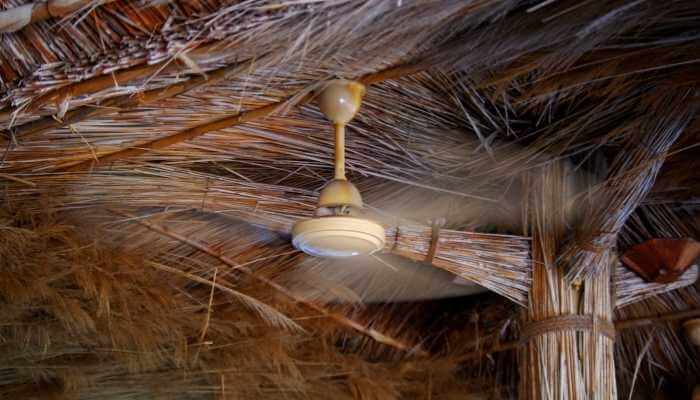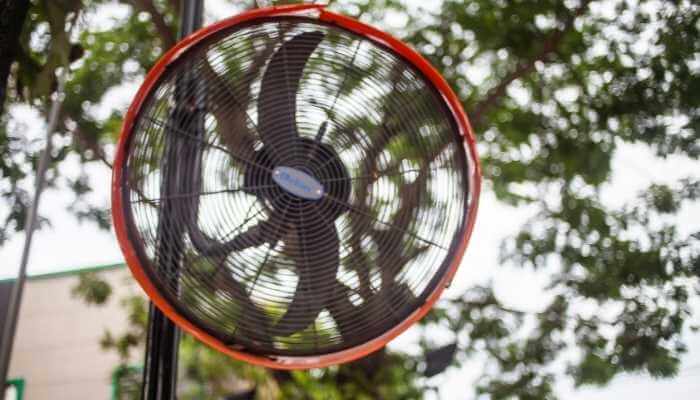When your patio has a roof – say a pergola, a sunroom, or a gazebo, you have the choice of possibly adding a nice fan to help you cool things off. They’re not just functional but decorative.
Although they are not as efficient as high-velocity fans, outdoor ceiling fans are perfect for an outdoor living space with a roof because they are made of durable materials specific to their use, can keep a large area cool by circulating the air, & can be a decorative addition to any aesthetic.
If you want to get information about using ceiling fans for cooling your outdoor living space down keep reading this article!
What Is the Difference Between High-Velocity Ceiling Fans and Standard Ceiling Fans?
High-velocity fans are usually more efficient at cooling an area and have greater durability than a regular ceiling fan. However, they work best in large spaces, because they tend to be loud and, well, powerful. Because of their ball-bearing motor, they last longer. They are portable, sure, but they are often not a piece that anyone would consider decorative at all.
High-velocity fans can be mounted on the wall, left on the floor, or you can find some pedestal models. They aren’t normally the type of fan that you would place on the ceiling in the middle of your outdoor living space. That’s because the speed allowed for a ceiling fan is dependent on the blade span and high-velocity fans are not limited by that.
High-velocity fans run at RPM speeds in the 1000s. But this chart tells you the velocity ceiling fans are allowed and then I added the square footage of the room size that works best with those sizes:
| Best Room Size (square feet) | Blade Span (inches) | Max RPM (rotations per minute) |
|---|---|---|
| Up to 75 ft² | 24” – 29” | 420 – 509 |
| 76 – 144 ft² | 30” – 39” | 275 – 410 |
| 144 – 225 ft² | 40” – 50” | 244 – 272 |
| 225 – 400 ft² | 51” – 60” | 204 – 240 |
| 400 – 650 ft² | 61” – 70” | 175 – 200 |
What Is the Difference Between Outdoor Ceiling Fans and Indoor Ceiling Fans?
Well, for one thing, outdoor ceiling fans are made from durable materials that can withstand high winds and outdoor elements – particularly moisture. They also have more powerful motors. Therefore, they may be a bit more expensive.
Also, placing an indoor fan outdoors could actually be a fire hazard. They aren’t made to keep any dampness in the air or rain from shorting out their electronics. Outdoor ceiling fans have a special protectant on their wiring and casements. There are two different ratings:
Damp Rated – These fans can resist moisture in the air but should be in a protected space away from heavy rain.
Wet Rated – These fans can withstand even heavy rain. As a matter of fact, you can wash these fans off using water sprayed from a garden hose.
Outdoor fans have blades made for the weather – not materials that will warp or rot. Stainless steel is the best choice, but aluminum, fiberglass, and plastic are less expensive alternatives. Also, their blades are generally larger than the blades of indoor fans. This offers more air movement.
How Difficult Are Outdoor Ceiling Fans to Install?
Outdoor ceiling fans are no more difficult to install than indoor ceiling fans. Most come with kits for installation into the roof or ceiling you’re using. Just keep in mind that the wiring is going to be an important difference. If there is a full roof overhand for the outdoor living space (a lanai or sunroom situation for instance) it’s exactly the same.
If you are attaching an outdoor ceiling fan to a pergola structure or a gazebo – there won’t be wiring already there and ready or a full space hidden above the ceiling for tucking wiring away. So you may need to hire an electrician to run the wiring to the mount for the ceiling fan. You’ll also need to be aware of how much space the blades of the fan need for clearance from the structure. Most use a down rod instead of a flush mount.
How Much Do Ceiling Fans Cost?
The good news is that ceiling fans will generally last 10 years, so long as you take care of them and don’t over-use them. So they are a good investment. Depending upon the materials you decide on and the size and design, you could spend anywhere from $85 to $500 or more on an outdoor ceiling fan.
Now, if you want to get really fancy – I’ve found some fans upwards of $1200. It’s all about style, materials, size, and design.
In Conclusion
It’s up to you when it comes to putting up a ceiling fan in your outdoor living area. The installation may be a bit much and the cost may be prohibitive of the actual coolness you get. You may decide that another method of cooling your area is preferable or that a portable, high-velocity fan is what you’d prefer to have. I just hope that my articles have helped give you some things to think about on your quest to stay cool in the heat of the year.














